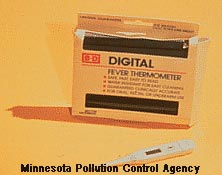Mercury in Medical Facilities

This HTML program teaches health care professionals (and anyone else) about the hazards of mercury as commonly used in medical care facilities, especially hospitals and clinics. Mercury can pose a significant health problem for these professionals, and also for patients and the environment in general. The program explains the impact of mercury on human health and the integrity of ecosystems, and a 'virtual hospital' allow users to see sources of mercury and their alternatives. Detailed survey and self-audit materials are provided, along with case studies from the Mayo Clinic and other locations. Created: 1997by Amy Childress, Alfred Krause, et al.; Revised, 2003
NOTE: On June 24, 1998, the American Hospital Association and USEPA
signed a Memorandum
of Understanding (PDF) ![]() (4pp, 90K About PDF) to virtually eliminate mercury-containing
waste from the health care industry waste stream by the year 2005.
(4pp, 90K About PDF) to virtually eliminate mercury-containing
waste from the health care industry waste stream by the year 2005.
Audiences:
- environmental professionals
- hospitals
- labotatories
- small businessesCreated: 1997by Amy Childress, Alfred Krause, et al.; Revised, 2003 concerned citizens
Download and install the software
- All you need to view the program is a Web browser
- Download Mercury in Medical Facilities - mercury.zip (compressed file, 6.1MB, unzips to 6.5MB)
- Double-click the file to uncompress and install the program. We suggest saving it to C:\Program Files\seahome\mercury\
- Start your browser and choose File > Open > C:\Program Files\seahome\mercury\src\title.htm
View the software online
The material you are about to view is a product of Purdue University.
This environmental software program was produced by Purdue University under a cooperative agreement with the United States Environmental Protection Agency.
Although this material was prepared in collaboration with EPA, Purdue University is the author, holds the exclusive copyright, and is solely responsible for its content subject to the terms of the cooperative agreemeent. Limitations under the copyright, which allows for free reproduction and distribution of the software, can be found on the program's title page.
EPA continues to work with Purdue University in developing new environmental software and updating older material, and we appreciate being notified of any errors or other issues.
![[logo] US EPA](https://webarchive.library.unt.edu/eot2008/20090509234039im_/http://www.epa.gov/epafiles/images/logo_epaseal.gif)